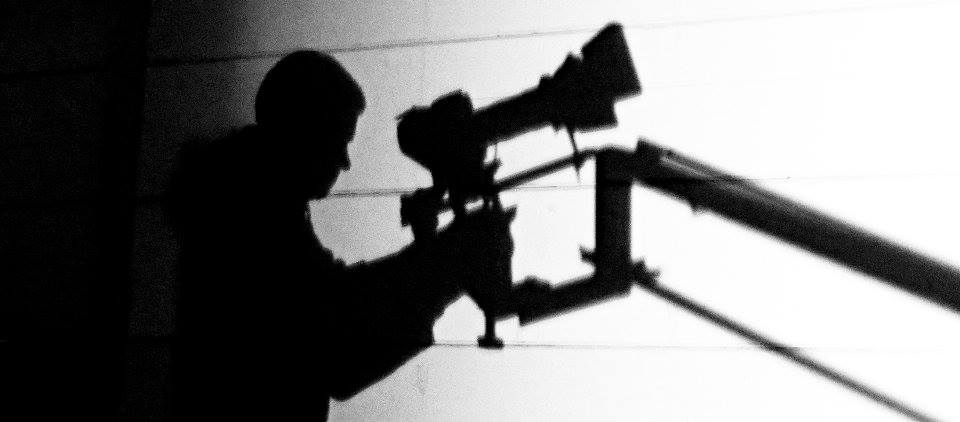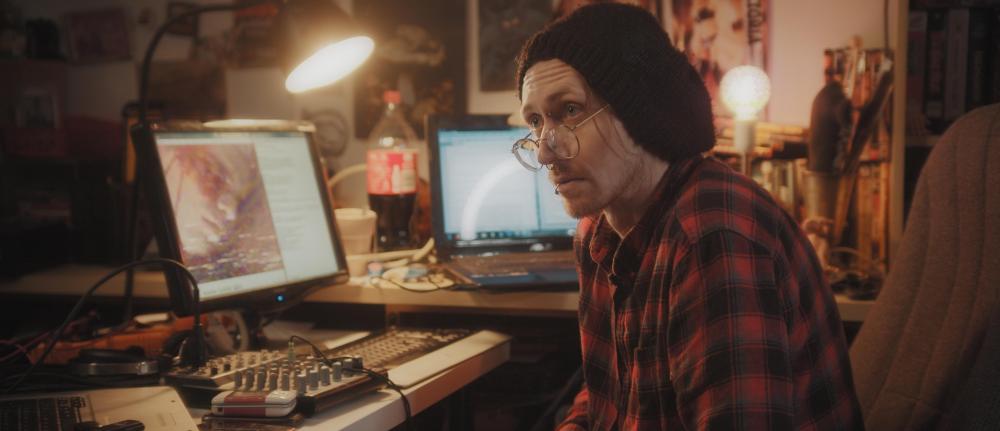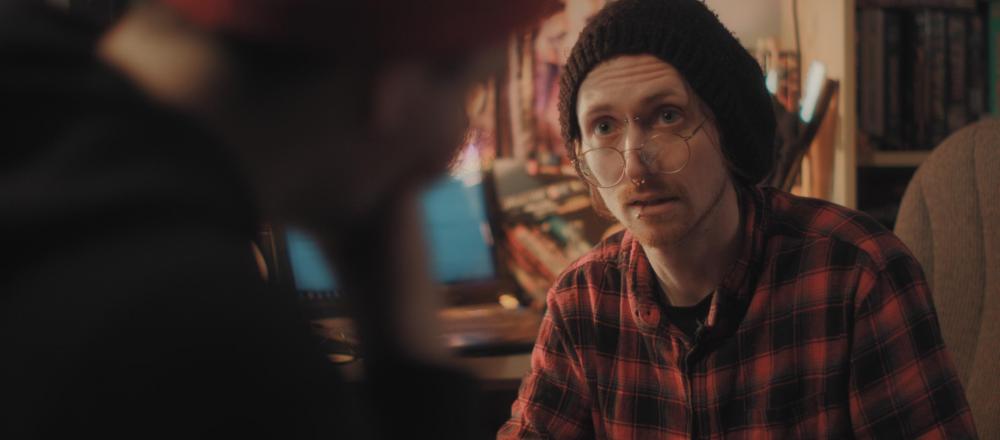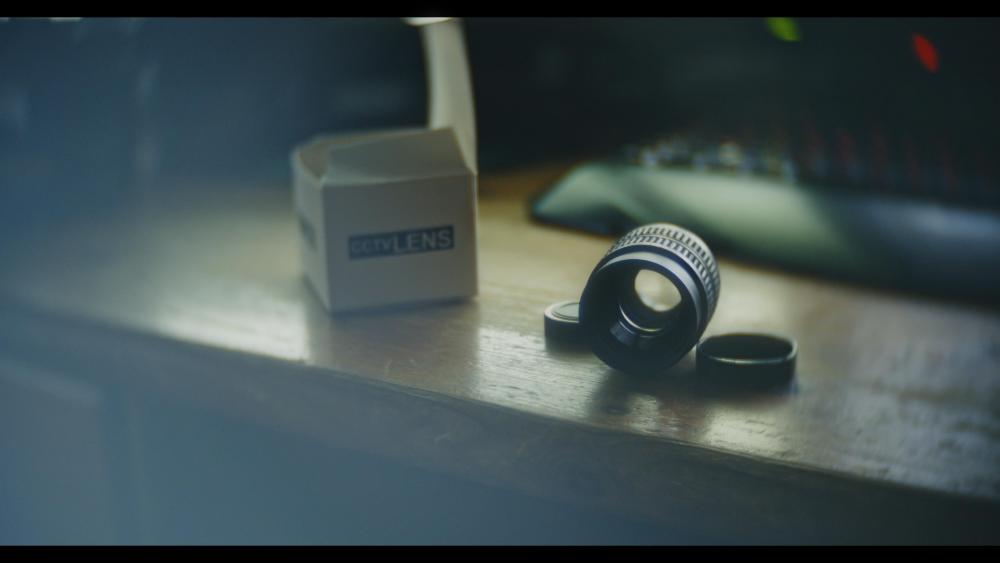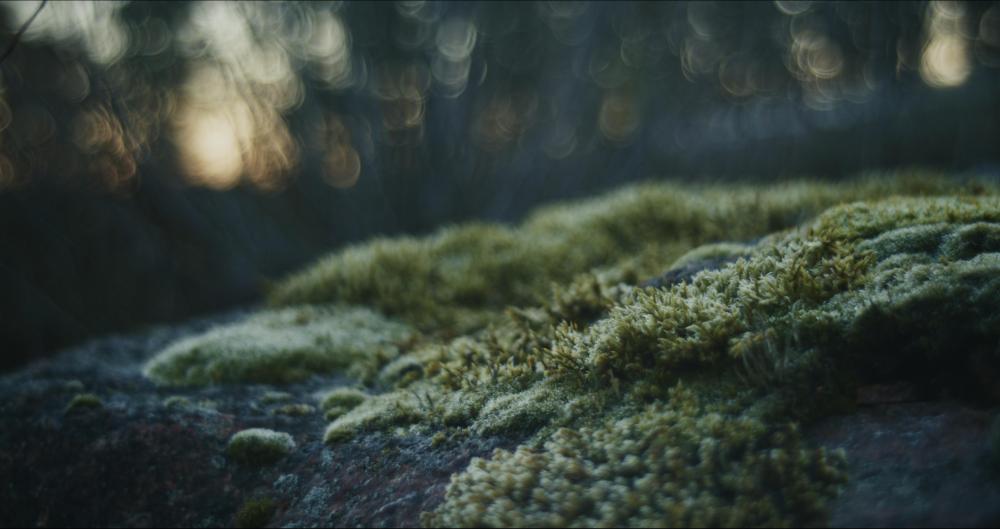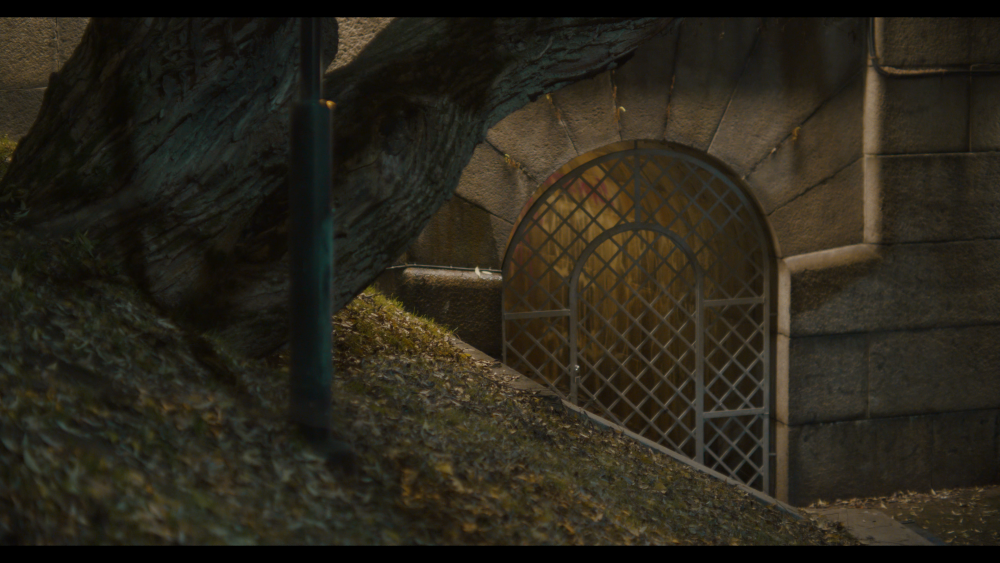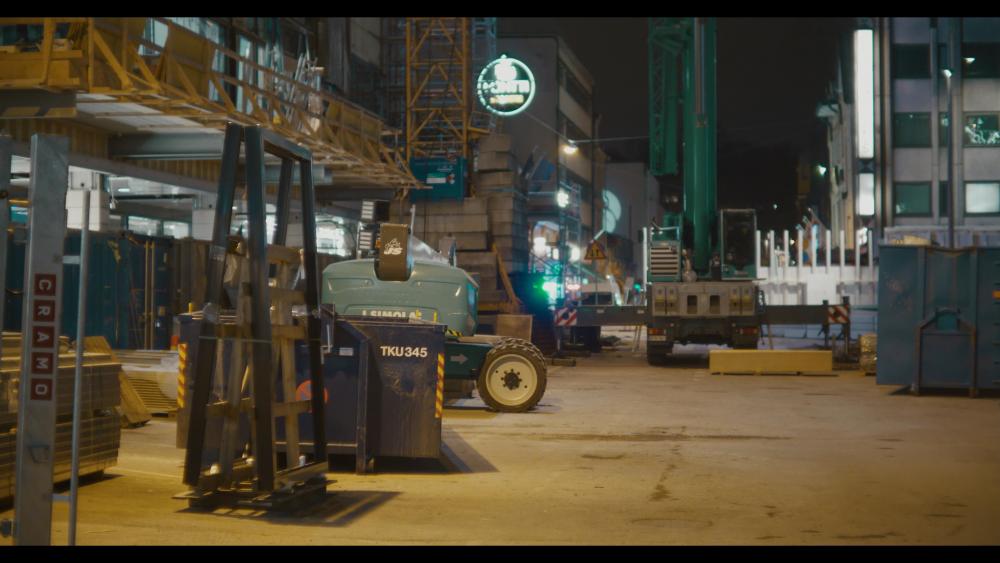-
Posts
121 -
Joined
-
Last visited
Content Type
Profiles
Forums
Articles
Everything posted by Ehetyz
-
So I've been shooting a new mockumentary/short movie where I'm using both the URSA Mini 4.6K and the Pocket 4K side by side, for interviews etc. Did some preliminary tests on grading the footage today, and they match quite nicely. Nothing scientific (and not all 100% going for cinematic since it is a mockumentary) about this one so it's not as if you can take it as a direct comparison - but I think some of you might find it interesting. Both cameras were at 800ISO (which theoretically is sub-optimal ISO for the Pocket but eh) and shooting at 4K Prores HQ, only difference in grading is that tint is set to -8 on the URSA and 0 on the pocket. Top one is Pocket, bottom one URSA. Looking at them full-res, the most obvious difference is that yes, the Pocket is sharper. I may have mistaken about in-camera sharpening in Prores - on the other hand, they have drastically different lenses too; Pocket is running on Sigma 18-35 at 1.8 and a speedbooster while URSA was shooting with a Takumar 50/1.2 which is quite milky by nature. Anyways, it's proving to be a nice b-cam for the big bro Ursa.
-
I don't think the P4K sharpens in-camera. Post-blurring might help make it look more vintage but also just using vintage/lower res lenses does the trick of not making it feel too sharp. Here's a test shot with a CCTV lens, Fujian 24/1.4.
-
^^ If that iphoneographers (lol) test were limited to just log it might be worth something, but it focuses on graded footage - graded by someone who's seemingly completely incompetent in it. Also, looks like it has unmatching color balance/tint between the BMPCC4K and the older cameras. Mind you, he may have dialed the color balance to match by numbers, but the old v1 color science is notorious for having off-whack white balance (where the most usable range was about 3800 to 5000K) and a heavy brown/green tint (for the past month I've been grading a feature film shot on Ursa Mini 4,6K and a BMCC2,5K and while I can match them well, the process always starts with transforming the 2,5K into Color Science v4 and dialing down the green tint). In the log footage you can clearly see the P4K having warmer image - likely dialed to be too warm for the situation. P4K uses the fourth generation color science which has its own quirks. I'm guessing after Ursa Mini and its proneness to magenta they pulled back towards green and slightly browner, less red yellow tones, since those are the colors I tend to have to tweak when matching UM and P4K. This leads me to believe that in the test they had the tint pushed towards magenta on the P4K or had a magenta cast coming from the LED light - because of the all the aberrations the P4K has, magenta cast isn't one I've encountered. I don't really even want to go all zealot on the P4K but the rose-tinted glasses towards the old BMD cameras feel extremely silly from the POV of someone who has used them for years and dealt with the headaches and color issues they had. Sure, like with lo-fi 8mm or 16mm film, you can have an opinion that it has more character than something more hi-fi. But they're certainly not superior and the V4 color science (even the in-camera V3 in URSA Mini 4,6K) are lightyears more malleable and pleasant to use.
-
So I've seen some derision about Pocket4K regarding it crashing or behaving erratically, as well as issues with the batteries. I thought I'd share my experiences with these. Short version: The battery that comes with the Pocket is utter, utter shit. Use original Canons instead and you'll see way less issues. Long version: That battery really is shit. I really can't overemphasize how shit it is. So, for me Pocket 4K was a no-brainer because I already had a lot of it's necessities lying around - Cfast2-cards, tons of compatible batteries. So, the latter has meant that I've been able to run the Pocket with not just the battery it comes with, but with a couple of relatively fresh (2-year old) OG Canon batteries as well as a few different off-brand ones (4-5 years old). So here's a short summary on how they have performed: Original Canon LP-E6: - No problems, can be charged in-camera or with my canon rechargers. Displays remaining battery accurately. No surprise shutoffs. - Drains the slowest of all the batteries I've tested. Still pretty fast, but quite manageable. Usually end up using 1-2 batteries a shooting day (b-cam). Off-brand LP-E6: - Like Canon, can be charged anywhere. - Depending on the off-brand battery, might or might not display the remaining charge accurately. - Can go from 40% to empty in seconds. So the 0-40% range is a bit of a wild card. May be due to inaccurate charge display or these might just be plain old and tired. - Drains faster than the Canon. The Blackmagic... thing: - Can't be charged with Canon chargers, causes them to enter fault mode (continuous blinking.) Occurs with both my chargers. Googling the issue has led me to find others with same experiences. Can only be charged through the camera. - Charge display is just whatever. Can go from over half-full to camera shutdown in seconds. - Sometimes works like an off-brand one. At worst, from full charge, lasted me around 3 minutes of recording before the first shutdown. - And notice the above? "First shutdown"? That was today. So, apparently the blackmagic battery is prone to just dying momentarily when there's a large power drain present. So what happened was, I set the camera to record, with battery at around 75-80%, and after a few seconds the battery meter goes haywire and the camera shuts down. Then it boots up again, and the battery shows up at 75%. Guess what happens when I hit record? Rinse and repeat. That was the moment I chucked the battery. Switched to Canon originals and the rest of the day went without a hitch. So, taking from this, I think some of the reported erratic behavior can be traced to the completely all over the place quality of the original battery. Having the camera reboot itself during recording is something that could be blamed on the camera if you have no way to troubleshoot and find the real culprit - which was the blackmagic battery. Maybe there are good ones too, but to stay on the safe side, I'd recommend just using it as a last resort backup at most, and sticking to Canon originals or maybe some higher-quality off-brand ones.
-
^^^This one is very useful and informative. It shows in great detail just how different P4K is to the earlier Blackmagic products ISO performance-wise.
-
I've seen good on-set camerawork totally ruined by terrible color grading, and mediocre work absolutely salvaged by a good, high effort grade. I've seen both happen to my footage and to the footage of other people. Nowadays I grade most of my work myself after a series of cases where the final graded footage looked way worse than what I had on my simple single LUT monitoring (due to being handed over to editors not experienced in grading). I would still like to do way better myself - after years with Resolve there are tons of things I'm still learning. Good color grading is absolutely essential in this day and age, at least on cinematic footage shot on LOG or RAW.
-
Yeah I'm gonna chalk this up as some serious rose-tinted glasses towards those old BMD:s. I'm not saying they're bad but I know I won't touch one with a ten foot pole today - and I used a BMCC almost exclusively for two years. Anything BMCC did the new BMD:s can do - and a lot more. In fact the original color science on the BMCC was kind of a pain in the ass in hindsight. Also consider the fact that you're comparing a camera that's been out for what, five years, with thousands of hours of footage available online, to a brand-new one people are slowly adopting and coming to terms with. Anyways, I'm having fun with my P4K and have already used it on ten or so commercial shoots. On gimbal, as a B-cam for stealing quick shots, and even as a broadcast cam on a christmas cooking show live stream - was able to match it perfectly to the URSA with my own custom LUT and it ran flawlessly through the show.
-
Not sure about the RAW controls on the Lite version, I've been using the paid/Studio version since 2014 or so. This one was made back when I used premade LUT:s pretty heavily, I think in this one I used a Visioncolor Osiris LUT, either KDX or Vision 4. In addition to the LUT I added a manual soft clip on overexposures and separated the skintones and gave them a warmer look than the rest of the image. I think there was a denoise on the first node as well, at a strength of 2.0. That's my go-to denoise level, on 4K/4.6K RAW footage it removes distracting noise but retains the detail. Aforementioned method provided a hard-edge, modern look to the footage, but currently I gravitate (in narratives) more towards the early to mid 90's filmlike look with softer details and tones, smooth rolloff, less contrast and more pronounced grain... And lots of haze. Probably because it reminds me of the movies I grew up with - and now it's actually attainable with low budget.
-
Thank you! Everything was shot in 800ISO, RAW 3:1. As far as exposure goes, the darker exterior scenes were underexposed, while using the flare pushed the whole dynamic range to use. The interiors were exposed "correctly" (I've later picked up a habit of exposing one stop to the right on the UM4.6K). I pulled down the shadows a bit in post. Funny thing about matching BMD cameras, the newest Resolve has an option to conform them into BM Color science 4, which has huge benefits. Not only does it make matching them a breeze (I've been grading a feature we shot with two cameras rolling throughout, URSA and BMCC2.5K), but it also alleviates some problems the previous color sciences have (Poor color distribution on BMCC, magenta tint on skintones on URSA). Saved me countless hours on mixing and matching the two cameras.
-
Thanks! I'm lucky to work with some very talented individuals. It wouldn't be what it is without the great FX/wardrobe/prop people.They bring my crazy ideas to life.
-
4.6K has worse low light (usable range maxes out at 800ISO) and is heavier (translates to requiring heavier rigs and tripods) but OTOH it also has hugely better ergonomics (you can actually shoot handheld/shouldered like an ENG camera), better sensor in many ways (bigger, higher res for oversampling, more DR, better color) more codec choices, better connections for broadcast shooting etc. You can actually use the onboard sound recording as well - if you have quality mics. Been working with one for two years now and while I love the Pocket 4K, Ursa is still the big brother, and Pocket the B-cam.
-
So I finally put my first Ursa Mini short film up on Youtube. It's a horror short called "Last Line of Defense" and was shot in spring 2017 to serve as a stress-test for the then-new Ursa Mini 4,6K. It's not a test video though, it's a full - if short- short horror film with serious effort put in the filmmaking essentials - from wardrobe to the effects. The main mission here was to put the UM into as extreme lighting situations as possible, so I drew up a story about a border station in some unknown future, where a group of men guard the station against an unknown threat, in the darkness, with only emergency flares to serve as lights. So we were able to experiment extreme contrast scenarios and low light. We shot the short film over a weekend, spending one night in the "border" set in the woods, and another one in the "bunker" set we built in the basement of our studio. The biggest cost in the whole short film were the emergency flares, of which I bought 10, mainly to get enough coverage for the finale - one flare gave us less than a minute of shooting time. This was my first touch with the Ursa Mini, and it's what sold me on the camera. The grade is quite simple by my current standards, but the images we were able to capture in those quite extreme lighting conditions turned out shockingly well. Most of shooting was done handheld with unstabilized lenses (Sigma 18-35 1.8, Samyang 24 1.4 and Pentax Super-Takumar 50 1.4) The forest set was lit with a set of Aputure Amaran led panels and a 4000K 1600 lumen light bulb that were all cast through a large diffuser, and the interior set used mostly a mix of small tungsten practicals and available sunlight. Once again, the worst bottleneck for the image quality ends up being the Youtube compression. Hope you enjoy the short, and feedback is very much appreciated
-
I've considered that but haven't bought them yet. I should probably give it a try.
-
There's a couple of projects I've done with that lens and P4K/Ursa but they're not available online yet. Here's one where I used almost exclusively lenses with distinctive bokeh, however it was shot on the BMCC2.5K and 5DMK2 (ML RAW). In this one I used the aforementioned lens, Super-Takumar 50/1.4 and a Petzval 85/2.3 to max out the old film noir kind of feel.
-
I picked up the one that was most readily available from local dealers, which was the Zhongyi lens turbo 2. It's an EF speedbooster and I just have simple M42-EF adapters on my M42 lenses (those adapters cost like 5-10 euros a piece). I think the lens turbo does a boost of 0,74x or something like that, essentially turning it into a Super35 crop. I found it to be optically good enough to mount a Samyang 24/1.4 or a Sigma 18-35 1.8 without noticable aberrations or degradation. I haven't seen any need for an IR filter at least so far - though so far I haven't used it in really extreme circumstances (ND+heavy sunlight) - it's the period of polar night after all. In any case, I think these new blackmagics are way better about IR pollution than the 2,5K. I use a Zhiyun Crane 2 currently. It's... okay. The first setup was a doozy, but it carries the P4K well. Requires a baseplate though due to how wide the camera is. It's the first gimbal I've owned and takes some getting used to. Definitely different beast than an oldschool steadicam, but way more pleasant to use than a full-size Ronin. Not 100% happy with my gimbal skills yet but I'll get there eventually.
-
Pairing the Pocket 4K with some good vintage glass is pretty blissful. There's been a lot of talk about how it looks more digital and modern than the previous BMD cameras - and yeah sure, I guess it's not as organic and grainy as the 2,5K. But throw on some c-mount glass or a speedbooster and old Pentax stuff and the camera sings. Haven't used it with this kind of setup on a production yet, (it's playing second fiddle to the Ursa Mini and been on a gimbal on about half a dozen shoots now) but I'm just having a lot of fun taking it on a walk and just taking some throwaway nature shots. It's something I used to do back when I used the 5DMK2 regularly, and I'm happy it has revitalized that habit again. This was taken with the speedbooster and a Pentax 35/2.3 M42 lens on a cool winter afternoon. One of my favourites due to the very distinctive, oil painting-kinda way it renders out of focus areas and the transition between them and in-focus areas.
-
Thank you for the kind words! I think the Ursa Mini is the first camera I've had in a long time that I genuinely like and respect without a huge string of caveats. It's a great workhorse. I'm trying my hardest not to sound like a shill but it's such a breath of fresh air to have a camera that's not gimped in one way or another.
-
I might be missing something here but you can adjust the settings of Crane 2 on the PC application. It gives you control over movement speed, deadzone, smoothness etc.
-
I just picked one of these up to serve as a b-cam/gimbal cam alongside my Ursa Mini and ran the first tests with it. First impressions; it's a beast. The ergonomics are spot on and as a former 5D2 user I feel right at home with it. The UI is essentially the same as in the Ursa Mini which is nice. And coming from the Ursa, and BMCC2,5K before that, the low light capabilities... they're just like, damn. I just want to go all run 'n gun and shoot my next short with all natural light. I ran a test on how far I could push it while still getting a clean image - ended up fitting it with a speedbooster and a Pentax SMC 50/1.2. I was able to ETTR at 50fps in city areas, and shoot comfortably in even extremely dim locations. In fact, I had to stop down/up the shutter speed on several occasions. The image wasn't 100% clean though - I'm assuming it's like in the previous BMD products, in that noise reduction is only applied in prores. I shot RAW so I had to do some cleaning up in Resolve (a process I've accustomed to with previous BMD products mind you - but in ISO 800 in their case), but the image did clean up very nicely and retained all the detail. It's probably the first time I'm seeing an actual cinema grade camera do low light this well. I felt that I could use a reflector to bounce the available light and the camera would actually pick it up. Attached two snaps from my short walk with the camera. Not very cinematic - but rather tests on how much data I could get from available nightime light. Quite a bit, even in indirect light, as evidenced by the second picture.
-
Thanks! I actually haven't tried working with H.265 at all, I'll give that a go.
-
Here's a new music video I directed, shot, graded and edited recently, for the Finnish punk/thrash metal band RiESA (Loosely translates to Burden). It's in Finnish, but I find it quite interesting even if you're not well versed in Finno-ugric languages. Their new album is a concept album, depicting a protectivist, totalitarian state controlled by a single dictator, and led by fear and propaganda. This gave us a nice opportunity to play with some 1984-like imagery and I'm quite happy with the end result. We did the video in essentially two days, with one day spent building the sets (the whole thing was shot in a basement of a local office) and one day of shoot. The interrogation room was mostly lit with practicals, with fluorescent tubes on the background and some IKEA spotlights lighting the posters. Only cinema lights used were two Aputure LED panels with diffusers used as fill lights. The jail cell was lit with one overhead 300W Fresnel and a 650W fresnel right outside the door to give us some heavy volumetric light. The propaganda scene was done simply with a home theatre video projector playing a video loop I prepared beforehand. I shot the whole video using modern EF lenses but with a Cokin P Pastel filter. It's one of my favourite diffusion filters as it gives a gorgeous bloom effect on light sources without eating too much into microcontrast or fine detail. You can see this if you watch the video in 4K, some of the skin detail is pretty astounding imho. And, not to sound like a Blackmagic fanboy, but I have to say the Ursa Mini delivered in spades, again. It's a fine workhorse. Visually the biggest downside is the youtube compression, which introduces banding, even here where the original image has some added film grain. Any feedback would be greatly appreciated, and if you guys have any questions about the production I'm happy to elaborate
-
I had the same kind of experiences with 5D mk2 ML RAW, loved that thing. Probably would still be using it if I hadn't picked up the Ursa Mini. I shot this one with pretty much my run 'n gun setup, as far as lenses go. I keep two sets of lenses, one set of fast, modern(ish) primes, and one set of vintage stuff for more cinematic shoots where we have time to light accordingly. Here I used the modern ones, Canon 35/2 IS for the handheld shots, and Samyang 24/1.4, Sigma 30/1.4, Pentax Super-Takumar 50/1.4 and Samyang 85/1.4 for the rest. No filters except a Genustech Eclipse Vari-ND for daytime shots. I used strictly available light here. That was sort of a self-imposed rule, I love shooting with natural light - and watching things shot in natural light. I'm a bit of a grognard in that sense, the more raw and less processed cinema is, the more real it feels to me. Which is why I think something like Aguirre - Zorn des gottes and The Sorcerer are the pinnacle of filmmaking. So the only "artificial" light here were the torches carried by the main character.
-
Thank you for the kind words. - And I agree, I find people's work methods a much more interesting subject than the neverending Canon bashing. I think one thing to take away from this one is how important it is to just let loose every once in a while. It really helps to revitalize the fun in filmmaking. And also that the URSA Mini just keeps continually amazing me with how versatile it is. I can't really exaggerate how impressed I was with its performance. Sometimes it's hard to get a grungy/gritty look right, in that it's dirty but still aesthetically pleasing, but the Mini made it a breeze - although I obviously have to also credit the wardrobe and our locations, especially the factory location was awe-inspiring IRL.
-
So I just released a project we shot a while ago. My long-time friend and collaborator, Jussi Huhtala, who has done most of the music in my films and other projects for over a decade now, released a post-apocalypse themed dark ambient concept album under his Oneiromancy project name, called Utqiagvik wasteland. Now, I'm a sucker for both post apocalypse and dark ambient tunes, so I decided I wanted to do a small music video/short film for the album, inspired by the title track. This wasn't a professional production, but instead I wanted to do this low-key, and old school. I started out in my parents' backyard, and a lot of my early stuff was pure guerrilla filmmaking. So that's what we did here. No lights or large crew, no protracted production. I picked out the locations, we gathered up some gear and had some corpse props made (These were the work of Minja Tuomisalo, a very talented FX/prop/set design artist), stuffed them all in the car and went our merry way, driving from one location to another and just shot... stuff. There was a vague script, but I intentionally wanted everything to be spontaneous. Too much planning takes the fun out of projects like this, and I wanted to improvise a lot. I shot the movie with an Ursa Mini 4,6K, and the thing performed once again admirably, even in less than optimal lighting conditions. The video spent quite a lot of time in the editing, but mostly because I was working on other projects and didn't have time for it. In the end, I'm happy with how it turned out, I think the music and the images create a nice, desolate atmosphere.
-
The online outrage/PC brigade has been completely out of line and out of control for a while now. The climate for discussion it has created is nothing short of sick. Now that the targets have expanded from the right to the middle and the left, maybe they'll end up having some real opposition. Hopefully.

